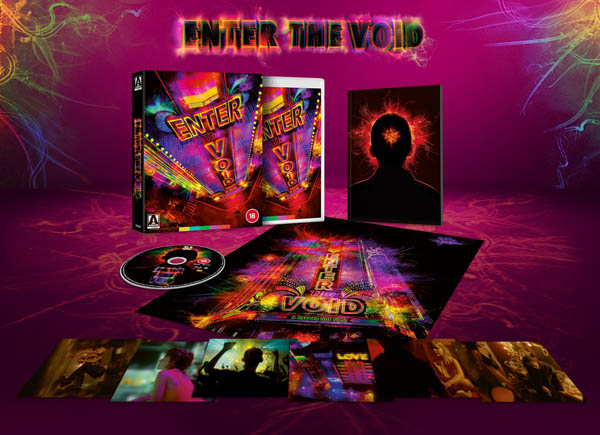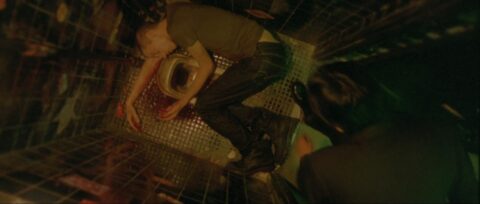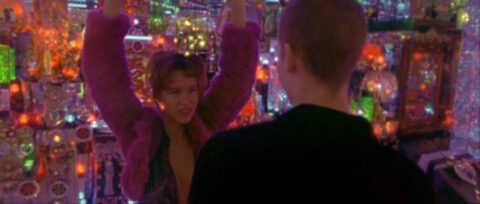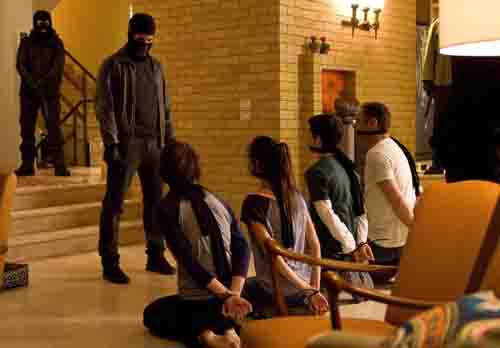Enter The Void (2009)
Directed by: Gaspar Noé
Written by: Gaspar Noé, Lucile Hadzihalilovic
Starring: Cyril Roy, Nathaniel Brown, Olly Alexander, Paz de la Huerta
FRANCE
AVAILABLE ON LIMITED EDITION BLU-RAY from ARROW FILMS
RUNNING TIME: 161 mins/ 143 mins
REVIEWED BY: Dr Lenera

Oscar lives in Tokyo with his younger sister Linda. She’s a stripper while he supports himself by dealing drugs, despite this being against the advice of his friend Alex, who attempts to turn Oscar’s interest toward The Tibetan Book of the Dead, a Buddhist book about the afterlife, which says that the spirit of a dead person sometimes stays among the living and fights being taken into a higher plane of existence, after which it attempts to reincarnate. During a drug deal at a bar called The Void, police swarm the place and Oscar is shot by a police officer. He then seems to rise into the air and look at his body from above, while recalling portions of his life….

One can see why it’s been depicted so often. The idea of us being dead but still being present in some way, and being able to see our loved ones carry on with their lives, is so poignant. The recent A Ghost Story was an especially poetic outing which employed this theme. But certainly the strangest one is Enter The Void, which still remains Gaspar Noé’s most unusual work despite it only being his third and him continuing to create unusual works. It’s a film which I enormously admired upon my first viewing, yet I wasn’t sure if I particularly liked it, if that makes sense. I haven’t been drawn back to watching it since, but jumped at the chance to view it again via Arrow Film’s new Blu-ray release of the film. Even when seen today, it’s an astonishingly original piece of cinema and a technical triumph. But is it more? Well I don’t know what I was on when I first watched it -perhaps an appropriate comment since the huge amount of uncriticised drug use in the movie which may really put off some newcomers if they have strong “anti” views on the subject, not to mention the fact that this writer happily admits that he has dabbled. But upon a second viewing it soon came to me that it was some kind of masterpiece. Well, it took me two showings to have revealed to me the brilliance of Casablanca so nobody’s perfect. Whether it still bests Irreversible which I consider to be possibly the top films of its decade is doubtful, but I can safely state that Noé’s astoundingly ambitious, existentialist follow-up does achieve most of what it seems to set out to do, perhaps the most important of which is provide a strong, relatable human dimension to its outrageous cinematics and its fascination with what many of us [not so much myself] may consider to be the squalid and the irresponsible. Style for style’s sake and grungy realism may sound like strange bedfellows, but Noé makes magic out of the combination, along with what seems to be a particularly depressing but actually rather truthful message about life.
It had been a passion project for Noé for some time. He’d been interested in death and the afterlife since being a teenager, and a viewing of 1947’s first-person film noir Lady In The Lake in his early twenties while under the influence of magic mushrooms made him decide that, if he ever made a film about the afterlife, that was the way in which it would be shot. He worked on different versions of the screenplay from 1992, the story originally being more linear and taking place in various other settings. The project was briefly under development for Tom Tykwer’s German company X-Filme Creative Pool in 2001, but was considered too expensive and the producers dropped out. Prospects changed when Irreversible became a commercial success. Wild Bunch were happy to produce Noé’s next picture, then deemed it too expensive until Noé began to develop it for Pathé instead, whereupon they asked him back. Seeing as Pathé were too slow, Noé returned to Wild Bunch. Having done many drugs in the past, he also took ayahuasca as “professional research”, while other influences included the experimental films of Kenneth Anger and the drawings of biologist Ernst Haeckel, Cast members were all non-actors except for the lead Paz de la Huerta. Very little dialogue was scripted, the performers asked to improvise. Shooting took place in Tokyo – where agreements were made with the local Yakuza crime syndicates – and Montreal, with little use of natural lighting but over a year of post-production with CGI employed in every shot. The 163 minute Cannes cut lacked much of the finished film’s sound design and some visual effects, then the next year the version released in American and British cinemas lost reel number seven, because Noé had promised the investors to make an alternative edit if the film ended up being longer than two hours and twenty minutes, reducing 161 minutes down to 143. Critical reception was wildly disparate and box office was poor.
Well this is Noé, so we get the end credits first, presented flashing very fast. Then come the opening credits, this time flashing much faster, forming pattern and set to industrial techno music. As usual, Noé is telling us that this is going to be an assault on the senses of the viewer. Our first shot is of the balcony of a Tokyo apartment where Oscar and his sister Linda are talking. “I wonder what Tokyo looks like from up there”? “‘ll be scared of falling into the void”. We get a sense of Oscar having gone astray somehow, surrounded by people who’re just after money and his best friend Alex just being a junkie. All this is presented from Alex’s point of view, which means that, of course when he takes DMT, we experience the hallucinations,and quite a trip it is, the psychedelic visuals quite stunning. The “point of view” camera reacts as if temporarily driven out of the body by the drug, spinning round and round before it goes back inside him, a taster of what is soon to come, though what’s really genius about all this POV business is that every now and again the screen briefly goes black from Oscar blinking; few filmmakers would have even thought about doing this! Oscar’s mate Alex turns up and wants to go and see Linda who’s working as a stripper, but first of all Oscar has to do this drug deal. At The Void Oscar enters alone and sits down with a distressed Victor, who mutters “I’m sorry” before police turn up. Oscar seals himself in a cubicle and attempts to flush his drugs. When the flush does not work, he yells through the door that he has a gun and will shoot. A policeman opens fire and hits Oscar, who falls to the floor. And here is where things take off in more than one sense.

From Oscar’s viewpoint, he rises and looks at his body from above, follows the progress of the crime scene for a while and visits Linda, though of course he can’t tell her the news. In one rather agonising scene, Linda and her boyfriend Mario, the boss of the club where she works at, are making out and the phone keeps ringing but she mostly ignores it and Mario even takes it away from her the one time she picks it up, after which they have sex. When she does finally get the news, she cries and the screen throbs in one of Noé’s most emotional uses of this device which he tends to mostly employ just to aggravate the viewer – and I don’t mean that as a criticism by the way. When so many films do very little when it comes down to it, aggravating the viewer every now and again must be seen as a positive. Anyway, the film now largely takes the form of flashbacks for a great deal of its length, with Oscar recalling his life, but this being Noé, this is not your typical flashback format. Incidents are non-chronological, some are shown really briefly while some are more dwelt upon and some even repeated, notably particularly traumatic incidents, these being are a car crash that kills Oscar and Linda’s parents, and their forced separation immediately after. The former is unsurprisingly graphic and one moment of the young Linda crying for a great many seconds is rather upsetting, but that’s the point; Noé wants you to feel the horror and the pain of what’s happened. The separation scene is also hugely emotional in an almost sentimental manner, revealing, as he’s done on a few occasions since, that Noé most definitely does have a heart, but a confrontational one that refuses to soft pedal anything. In the present things aren’t going too well, but Oscar can’t do anything, or can he? In one especially bonkers bit, he enters Linda’s head and experiences a dream of hers in which he comes back from the dead. Plot eventually veers on the edge of disappearing, but then Noé pulls off his cheekiest homage yet to 2001: A Space Odyssey.
Corruption is a major theme, with Oscar soon involved in illegal activity [in a country that is very strict on drugs!]and his poor sister, whom Victor suggests comes over, quickly falling into things too. Oscar sleeps with a Japanese lady and gets her to take drugs for the first time; he also gives the innocent Linda drugs. He’s far from upstanding, a bad influence on others, so maybe we can think of his being trapped between two planes of existence as a sort of purgatory.. In Irreversible, we were asked to consider the ramifications of decisions we may make. Here, it seems that we’re asked to consider the effects of the ones we have made. Oscar’s torment is to see this, and while he can do the odd trick he can’t change anything in terms of others, though it’s slightly possible that he’s able to alter his own destiny after spending much time imprisoned between two worlds. Said finale does climax [sorry I couldn’t think of any other word and I’m pushed for time] a not just oedipal but incestuous element which will probably disturb some, especially because it’s not really explained. Oscar sleeps with Victor’s mother, but her mounting him and him being at her breast causes a flashback to – um – a baby Oscar sucking his mum’s breast. Another flashback has him witness mum and dad at it but then dad turns into Alex. Sister kisses brother rather more than seems normal even for a deep sibling. I don’t think that there’s any deeper reason for all this but that Noé likes to get at the viewer. After all, he’s just as interested in getting him or her to experience a drug-like state. A great amount of the running time is taken up with the camera – and therefore us – floating through rooms and above buildings, often seeming to go towards something to enter before making slowly spinning round and then entering, cue for some psychedelic imagery before we exit somewhere else in the world.
Nathaniel Brown is wooden in the few moments we see him, but generally the non-actors do well. Paz de la Huerta is allowed one strong moment of grief and is a quietly strong presence throughout, though a subplot of Alex liking Linda could have done with being a bit more present. I’d have been content with losing a few minutes of floating and flying to incorporate the former, even though I liked all the floating and flying. A gay character in this movie is portrayed as being only slightly better than the rapist in Irreversible, but I don’t think that there’s any real hate here even though many today will probably read between the lines and not like what they see; it’s just Noé messing with the anxieties that many of us have even though we may not think we do. Curiously the soundtrack is surprisingly low key; the slow techno of the many club scenes is very muted in the sound mix and the main theme, heard in three different versions, is Johann Sebastian Bach’s “Air on the G String”. Apparently when you die your brain releases something that’s the same as what gives you a DMT journey, and it’s possible to see the idea of “death as the ultimate trip” as facile and even insulting. But I think that Enter The Void remains Noé’s most personal and revealing film. He does seem to tell us that, despite drugs offering us temporary escapes from reality, their overuse is a shallow existence, though nothing we do really matters in the great scheme of things anyway, because we’re all going to die eventually. The Void is not so much the afterlife or anything in between but life itself. So lets enjoy it in a reasonably balanced fashion if we can.
Rating: 









LIMITED EDITION SPECIAL FEATURES
High Definition Blu-ray (1080p) presentations of both the 143-minute UK theatrical cut and the full-length 161-minute director’s cut
Arrow use the same stunning transfer they used for their previous release. The loss of Reel Seven in the UK theatrical cut means that we don’t see a lesbian scene, which perhaps isn’t crucial and in fact seems rather pointless. However, we do also lose out on the bizarre scene of Oscar becoming part of Linda’s dream and some important little bits of dialogue, such as Linda regretting she didn’t go out with Alex instead of Mario. I haven’t watched the film without these bits, but don’t feel a desire to. There’s other material that Noé could have more beneficially cut.
Original lossless DTS-HD Master Audio 5.1 and PCM 2.0 stereo soundtracks
Optional English subtitles for the deaf and hard of hearing
Enter the Sensorium, a brand new visual essay on the film by author and critic Alexandra Heller-Nicolas [16 mins]
Arrow have added two new featurettes and retained all their previous special features. Here, Heller-Nicolas rushes through the film with not really enough time, making observations as she goes while we see various clips. She succinctly narrows down the essence of Noé’s work to being “cinema that feels”, and related to that says that any religious aspects are far less important than the experience this film gives you, while also mentioning how there are all kinds of different “voids” in it. All very good, but far too brief.
Brand new video interview with typography designer and long-term Noé collaborator Tom Kan [41 mins]
This is a pretty in depth piece as Kan talks in detail about how got started in movie typography, beginning with copying the writing on movie posters, to working with other collaborators, to his work with Noé which as well as Enter The Void, where a huge number of pop cultural designs were used in the opening credit sequence, includes some material on Lux Aeterna and Climax, where Kan feels that Noé was unsure the film would be successful judging by the credits. He also tells us why logos in films are sometimes different from the ones on the posters, and why Noé likes his credits at the front. Consistently fascinating.
8 deleted scenes [12 mins]
Three of these supposed scenes only last a few seconds and are barely worth mentioning. However, but we also get; Oscar discussing women and drugs with Alex, Oscar discussing other halves with his Japanese girlfriend as well as trying to get her to take drugs again, a lengthy POV walk through tunnels, Linda kicking out a client who wanted more from her lap dancing – and best of all, a moment that should have been kept in even if the other ones remained cut – Linda and Mario in the car with Linda getting hugely upset at Mario not caring, presumably about Oscar’s death but maybe about another traumatic event that occurs later. It’s one of Huerta’s finest moments.
Archival Making of – Special Effects featurette [11 mins]
A wordless montage comparing finished scenes with their CGI pre-visualisation – and you’re be amazed exactly how much is CGI. There’s probably as much of it as there is any Marvel film.
Archival Vortex featurette [5 mins]
Some of the trippy visuals placed together for you to watch the next time you do drugs – or just put on the right music and get high anyway.
Archival DMT Loop featurette 2 mins]
Ditto.
French and international theatrical trailers [3 mins]
8 teaser trailers [2 mins]
3 unused trailers [5 mins]
Image gallery
Limited edition packaging with reversible sleeve featuring two choices of artwork
Illustrated collector’s booklet featuring new writing on the film by Jon Towlson and Rich Johnson, and an oral history of the film by Steven Hanley
Fold-out double-sided poster featuring two choices of artwork
Six double-sided, postcard-sized artcards
I found ‘Enter The Void’ to be very rich and rewarding with this second viewing, but it’s most definitely cinema that’s as experimental and offbeat as a commercially released film can be. Arrow’s Blu-ray could have done with an audio commentary – hell, this film could do with four – but where would you start? Highly Recommended for lovers of the offbeat.
Read Matt Wavish’s review here




Be the first to comment